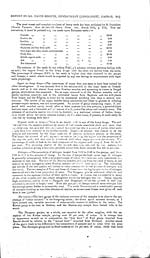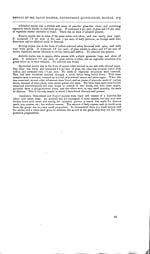Medicine - Drugs > Report of the Indian Hemp Drugs Commission, 1894-1895 > Volume III
(208) Volume 3, Page 204
Thumbnail gallery: Grid view | List view

204 REPORT OF THE INDIAN HEMP DRUGS COMMISSION, 1893-94. [APP.
the district or town
itself yields 14.46 per cent. The ganjas from Ootacamund,
Bangalore,
Tanjore, and Madras city come from the Javadi hill, yet they yield
21.68, 18.5, 17.37, and
13.92 per cent. of resins respectively. The "country ganja"
imported from Coimbatore
and used on these hills contains 14.64 per cent. of resins, but a
sample obtained from near the
town of Coimbatore gave 18.44 per cent. We may learn from the
analyses of the samples
from Nimar in the Central Provinces that, whether from local or
imported seed, the ganjas grown
in the same district and under the same circumstances yield similar
products. With regard to
the nature of the resinous extract of ganja, it is insoluble in
water, but soluble in alcohol with a
neutral reaction. A small amount of resin acid, about half per
cent., was present in all the
samples of ganja and bhang. A certain amount of the resins
dissolves in warm potash solu-
tion (one per cent.); a still further quantity is dissolved by
treatment with alcoholic potash,
evaporating to dryness, and washing the insoluble resin. Ganjas
treated in this manner give
from 50 to 60 per cent. of purified resin, and bhangs from 40 to 50
per cent. It is thus
shown that the resinous extract of the bhangs is not equal, weight
for weight, to that of the
ganjas, as it contains a smaller proportion of purified resin which
has been proved to be active.
The bhangs contain from 8.31 to 12.63 per cent. of resins, or an
average of about 10 per cent.
which is one-half the amount yielded by average samples of ganja.
Charas, it will be seen, con-
tains, on an average of fifteen samples, about 40 per cent.
resinous extract, which is double the
quantity afforded by ganja.
The ash of ganja and
bhang.-The amount and composition of the ash of hemp drugs is
more
uniform than those of tobacco. The proportion of total ash of ganja
is generally under 20
per cent. If it is over this proportion, a glance at the figures
under "insoluble ash" will
show that it is due to an excess of sandy residue. The soluble ash
(alkaline salts) does not ex-
ceed 3.43, nor fall below 1.67 per cent. The ash soluble in dilute
hydrochloric acid (lime salts,
etc.) falls between 13.57 and 8.68 per cent. The sand (insoluble
ash) is the most variable
constituent, as it ranges from 8.53 per cent. in the Tanjore sample
to 2.18 per cent. in the
Kistna drug. The alkalinity of the ash shows much attachment for
the figure 1. The pro-
portion of total ash in the samples of bhang in every case exceeds
20 per cent., a result which is
due to the larger amounts of lime salts, as well as sand, than are
found in the specimen of
ganja. In the analyses of wild hemp plants, the male plants appear
to yield more ash than the
female plants, but the latter more resin. The composition of the
Basti "bhangi plant" is
not in keeping with the above statement, and is abnormal in
yielding so much extract to spirit
and so small a quantity of ash.
Following is an analysis of the ash of bhang from Bhagalpur:-
|
K2O |
CaO |
MgO |
Fe2O3 |
P2O5 |
SO3 |
Cl. |
SiO2 |
CO2 |
|
8.98 |
22.27 |
6.31 |
2.17 |
7.77 |
3.08 |
1.55 |
32.36 |
11.46 |
traces of manganese, undetermined, 4.06=100.
The analysis of the ash of "chur" ganja from Naogaon gave the following figures:-
|
K2O |
CaO |
MgO |
Fe2O3 |
P205 |
SO3 |
CI. |
SiO2 |
CO2 |
|
10.42 |
21.66 |
5.46 |
3.21 |
7.67 |
2.31 |
0.96 |
36.00 |
7.33 |
traces of manganese, undetermined, 4.98=100.
There is a great
similarity in the composition of the ash of ganja and bhang. They
are
both fairly rich in calcium phosphate, and the ash from ganja
contains more potash than that
of the bhang.
Remarks on
charas.-Charas has very seldom been examined chemically.
Flückiger and
Hanbury, in " Pharmacographia," second edition, page 550, report
that charas yields from one-
quarter to one-third of its weight of an amorphous resin, and Dr.
Prain in his report refers to
samples yielding 75 and 78 per cent. of resin. It will be seen from
the results of my analyses
of North Indian samples that the average yield of resin is 40 per
cent. The highest is 46.5
per cent. in "mashak" charas from Amritsar, and the lowest is 22.3
per cent. in a sample of
charas made from wild plant grown in Kumaon. The latter sample has
the composition of a
good sample of ganja. The samples from Amballa, Amritsar, Delhi and
Bombay are remark-
ably uniform in their composition and physical characters. They had
a similar odour, con-
sistence and colour, and all contained a large amount of sand. The
Gwalior and Himalayan
samples had portions of leaves and sometimes, seeds mixed with
them, and left a quantity of
vegetable residue after extraction with spirit, but there was not
so much sand present. The
Yarkand charas had some carbonate of calcium present, and the ash
soluble in hydrochloric
acid was consequently high. There was very little in the resin
contents and appearance of the
Delhi samples to determine their money value. The best quality had
less resin and more sand
than the other two kinds; it was more plastic and contained more
water than they did. If
alkaloids were the active principle of charas, then one would
expect to find them in great abun-
dance in this drug. But this is not so; some of the samples gave no
indication of the presence
of alkaloids, and the others only afforded traces. The amount of
nitrogen is lower in charas
than any other hemp drug. The Gwalior sample yielded 1.75 per cent.
of nitrogen which
apparently was derived from the vegetable matter, as the " mashak"
of Amballa, which con-
tained half the amount of insoluble vegetable matter, gave half the
percentage of nitrogen
(0.84 per cent).
Remarks on
majum.-The confection of hemp known as majum is differently
made in
various parts of India. In the north it is made with white sugar,
in the south it is made
with brown sugar and mixed with so many spices and other
ingredients that it is quite black.
Set display mode to: Large image | Zoom image | Transcription
Images and transcriptions on this page, including medium image downloads, may be used under the Creative Commons Attribution 4.0 International Licence unless otherwise stated. ![]()
| India Papers > Medicine - Drugs > Report of the Indian Hemp Drugs Commission, 1894-1895 > Volume III > (208) Volume 3, Page 204 |
|---|
| Description | Volume 3: Appendices. Miscellaneous. |
|---|---|
| Attribution and copyright: |
|




